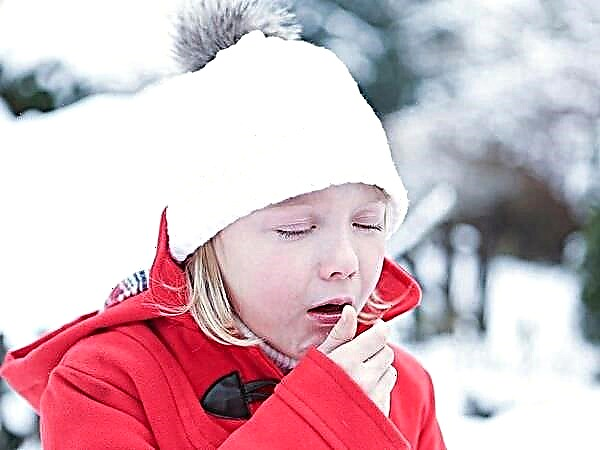
In the treatment of rhinitis, vasoconstrictor sprays are often used, among which Otrivin is very popular. Especially for children, it is produced in a reduced dosage and on the box of this Otrivin there is a mark “for children”. From what age and when is it prescribed for young patients, how often is it used for a cold and what similar means is it replaced?

Release form
The drug is a metered-dose nasal spray. It comes in small polyethylene bottles that have a dispensing pump that is closed with a protective cap.
The volume of the drug in one package is 10 ml. The solution inside the bottle is colorless and transparent, with no odor.

Composition
The concentration of the active ingredient in Otrivin for children is 0.05%. This means that in each milliliter of solution there is 0.5 mg of xylometazoline in the form of hydrochloride.
Additionally, the medication contains sodium chloride, 70% sorbitol, 50% benzalkonium chloride and pure water. The spray also contains edetate disodium, hypromellose, hydrogen phosphate and sodium dihydrogen phosphate.

Operating principle
Otrivin is a vasoconstrictor drug, and its effect on blood vessels is associated with alpha-adrenomimetic action. Once on the nasal mucosa, the solution acts on alpha-type adrenergic receptors, which leads to vasoconstriction.
The effect of the spray begins to develop after 2 minutes and lasts up to 12 hours. The medication quickly eliminates swelling and reduces the severity of redness.

Thanks to the use of Otrivin, mucus hypersecretion is suppressed, and the drainage of the nasal passages is improved. All these effects lead to the elimination of the feeling of nasal congestion and the improvement of nasal breathing.
Thanks to hypromellose and sorbitol in the spray, the drug additionally moisturizes the mucous membrane, and also prevents dryness and irritation (symptoms that often appear during treatment with xylometazoline).
Indications
The drug is prescribed for children:
- with ARVI, if a runny nose is one of the symptoms of the disease;
- with acute rhinitis provoked by allergens;
- with sinusitis;
- with eustachitis or otitis media;
- with pollinosis.
In addition, the spray helps to prepare the nasopharyngeal mucosa for diagnostic manipulations or surgical treatment in this area.


At what age is it prescribed?
Treatment with Otrivin for children is prohibited until 2 years of age. If the child already 2 years old, the drug can be used, but for patients under six years of age, medical supervision is required.
For children over 12 years old, such a medication is usually not prescribed, since its dosage is insufficient to treat adolescents (you should already use Otrivin for adults).

Contraindications
Otrivin for children is not applied:
- with tachycardia or high blood pressure;
- with glaucoma;
- with hypersensitivity to any ingredient in the solution;
- with hyperthyroidism;
- with atrophic or dry rhinitis.
The drug is prohibited for patients who have undergone surgery on the meninges in the past.
Children with pheochromocytoma, diabetes mellitus and hypersensitivity to adrenomimetics require special care when treating with Otrivin.

Side effects
Treatment with Otrivin for children can lead to:
- sneezing;
- tingling or burning sensation in the nose;
- dryness of the mucous membrane;
- headache;
- nausea;
- insomnia;
- an allergic reaction;
- high blood pressure;
- feelings of palpitations.
Very rare side effects of the drug are called visual impairments, Quincke's edema, tachycardia, heart rhythm disturbances, vomiting and other problems. When they appear, the use of Otrivin is immediately stopped and a doctor is consulted.

Instructions for use
A child under 6 years old (aged 2-5 years) is injected with Otrivin in each nostril with one press.
For six-year-old patients and older (up to 11 years old), the doctor can prescribe either one or two injections into each of the nasal passages at once.
The frequency of use of the drug in children from 2 to 5 years is 1-3 times a day, and patients 6-11 years old are prescribed two or three times. The last injection is advised to be done at night. More often than three times a day, Otrivin for children is not prescribed.
The duration of treatment is determined individually, but it is not recommended to use such a drug for more than 10 days, as this threatens the development of medication rhinitis or can cause atrophic changes in the mucous membrane.


Overdose
If a child accidentally drinks the drug or the drug gets into his nose in an excessive dose, it will cause increased sweating, a decrease in body temperature, bradycardia, severe dizziness and other negative symptoms. Such situations require immediate medical attention.
Interaction with other drugs
The drug can not be combined with some antidepressants, sympathomimetics and medicines from the group of MAO inhibitors.

Terms of sale and storage
You can buy the spray at the pharmacy without a prescription. On average, one bottle of baby Otrivin costs 150 rubles. It is advised to store the drug at home at room temperature, placing the package out of the reach of small children. The shelf life of the spray is 3 years.

Reviews
There are many good reviews about the treatment with Otrivin for children. One of the main advantages of the spray is called a very quick onset of action. According to moms, the medicine relieves swelling in just a few minutes and allows the child to breathe normally through his nose.
The benefits of the drug include the possibility of long-term storage, a convenient bottle and an affordable price. The disadvantages of Otrivin for children are its side effects, for example, a burning sensation after injection.

Other types of Otrivin in the form of a spray
In addition to Otrivin for children, you can find other sprays in pharmacies, the name of which contains the word "Otrivin":
- Otrivin Moisturizing Formula. The packaging of this medication is marked "for adults", but it can be used in children from 12 years of age. This age limit is associated with an increased concentration of xylometazoline - 0.1%.
- Otrivin Menthol. This 0.1% spray is also intended for adults and can be used from the age of 12. Its difference from the previous type of medicine is the presence of menthol and eucalyptol in the composition.
These ingredients not only give the solution a special smell, but also have a cooling effect.


- Otrivin Baby. The basis of such a preparation is natural sea salt, and the solution itself is isotonic. The medication is approved from the age of three months and is used both for nasal hygiene and in the treatment of rhinitis. Its use moisturizes and cleanses the mucous membrane well.
- Otrivin More. This spray contains sea water and is in demand for cleaning or moisturizing the nasopharynx. In children, it can be used from 3 months.
- Otrivin More Forte. This medicine is also based on sea water, but its solution is hypertonic, due to which the spray effectively eliminates the swelling of the nasal mucosa. Children are prescribed it from 6 years old.
Analogs
Otrivin for children can be replaced by another medicine, the main ingredient of which is xylometazoline... It can be Tizin, Galazolin, Xylometazoline, Snoop, Rinostop, Xylen, Rinonorm, or another drug. In addition, with a runny nose, the doctor may prescribe medications with a different composition, for example, Aqua-Maris, Nazivin, Marimer, Nazol and others.
For information on how to treat a runny nose in children, see the next issue of Dr. Komarovsky's program.



